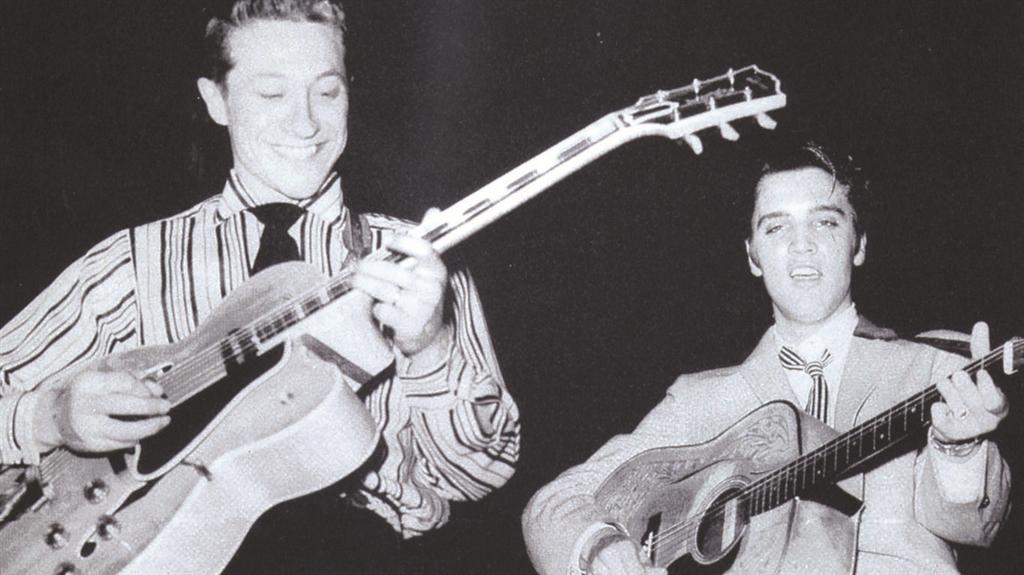Randall Roberts
June 29, 2016
http://www.latimes.com/
June 29, 2016
http://www.latimes.com/

Scotty Moore and Elvis Presley
If the history of rock ’n’ roll is a series of Big Bangs that pop at random intervals, the explosion that occurred on July 5, 1954, at Sun Studio in Memphis, Tenn., when Elvis Presley, guitarist Scotty Moore and upright bassist Bill Black tore into "That's All Right" was a particularly cosmic occurrence.
As the electric guitarist steering the music, Moore, who died Tuesday at age 84, lighted Elvis' fuse during the first of what came to be known as the Sun Studio sessions. Moore was the last surviving member of a backing band that upended popular music, helping to propel not only an American musical revolution but also playing a critical role in the birth a whole sub-genre, rockabilly.
Aside from the towering work of Chuck Berry, no guitarist played a bigger part in establishing the electric guitar as the driving force of rock ’n’ roll.
Sixty-plus years and thousands of distortion pedals later, Moore's playing might sound quaint, but echoes of his fretwork can be heard in the sounds of the Rolling Stones' Keith Richards, George Harrison of the Beatles, Jimmy Page’s work with Led Zeppelin and pretty much every other British band of the 1960s.
The skinny kid with a tight pompadour held a hollow body electric guitar that seemed a few sizes too big for him, but he dotted out strong melodic accents with a minimalist grace and precision. That tone has wended its way through the music of acts as varied as punk bands the Clash, X and Rancid, and is so woven into the DNA of rock as to appear invisible.
That first musical propulsion took place at the tail end of a session at Sam Phillips’ Sun Studio that hadn’t generated much spark. Presley, who’d relentlessly pursued a session at Sun, was nervous. He and the band had worked on a treacly ballad, “I Love You Because,” and were getting ready to take a break when Moore and Presley started fooling around.
Recalled Moore to Presley biographer Peter Guralnick in "Last Train to Memphis: The Rise of Elvis Presley," “All of the sudden Elvis just started singing this song, jumping around and acting the fool, and then Bill picked up his bass, and he started acting the fool too, and I started playing with them.”
Moore recalled that producer Phillips was preoccupied in the control room but that when he overheard the music, “he stuck his head out and said, ‘What are you doing?’ And we said, ‘We don’t know.’ ”
When Phillips played the tape back, the players were stumped. “It just sounded sort of raw and ragged,” Moore recalled to Guralnick. “We thought it was exciting, but what was it?”
It was the sound of the new, a hard-driving R&B number from would-be country balladeers. Ex-Navy man Moore may have started as a middle-of-the-road country and western player, but the blues tones filling the Beale Street clubs in Memphis affected his approach, and that culture clash resonated.
Throughout those Sun Records sessions, Moore’s solos became templates. If it wasn’t his magnetic uptempo run on “That’s All Right,” it was his sparse, mournful meditation during “Blue Moon.”
Moore’s downbeat riff during the fast version of “I’m Left, You’re Right, She’s Gone” hits with a rocksteady swagger. During the slow version of the same song, Moore adds a twang-bar menace that suggests the simmering work of Duane Eddy.
Moore’s musical relationship with Presley wasn’t all roses. As the singer’s star ascended, Moore, Black and drummer D.J. Fontana didn’t share in the prosperity. They were still getting sideman wages, touring and watching the ascendant King accrue fame and power.
As reported in “Last Train to Memphis,” Moore delivered his first resignation to Presley in 1956 at the Beverly Wilshire Hotel. Before the end of the year, though, he and Black were back in the fold – with substantial raises.
After that big rush of fame, Moore continued to innovate on the guitar, even if he never stepped out from the King’s shadow. As classic rock ’n’ roll merged with rockabilly, Moore became the patron saint of a movement that continues to draw generations of fans.
Unlike his more famous singer, though, the guitarist could still walk the streets unrecognized. That’s to be expected. Though his impact was just as forceful, Moore understood that his role was to reside outside the maelstrom that was Presley and transform that energy into a sound.
ALSO
No comments:
Post a Comment